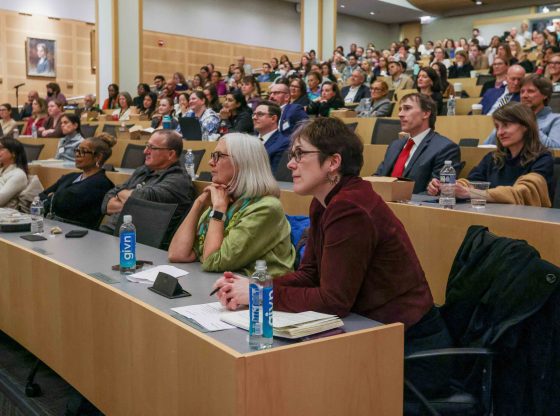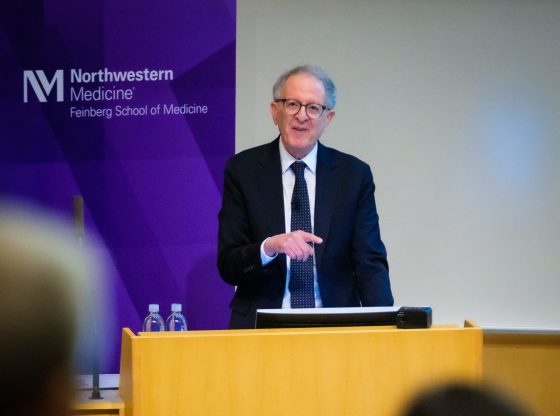Despite recent NIH findings showing that health disparities research and underrepresented minority scientists lack significant federal funding, the scientific community “has not embraced the message,” blocking progress towards health equity, according to a recent Northwestern Medicine editorial published in the Journal of the American Medical Association.
The article was co-written by Mercedes Carnethon, PhD, the Mary Harris Thompson Professor of Preventive Medicine in the Division of Epidemiology and of Medicine in the Division of Pulmonary and Critical Care, Kiarri Kershaw, PhD, MPH, associate professor of Preventive Medicine in the Division of Epidemiology, and Namratha Kandula, MD, MPH, co-director of the Center for Community Health in the Institute for Public Health and Medicine (IPHAM) and associate professor of Medicine in the Division of General Internal Medicine and Geriatrics and of Preventive Medicine. All three scientists are members of the Center for Epidemiology and Population Health.
“The reasons underlying funding gaps for health disparities research and black scientists are complex and deserve continued attention,” the authors wrote. “However, the latest findings should spur funding agencies to make greater investments in funding and review processes that are structured to maximize representation of health disparities scientists from underrepresented backgrounds. Only by doing so will the NIH promote scientific innovation in a manner that can eliminate disparities and promote health equity around the world.”
Read a Q&A with the authors below.
What was the motivation behind this viewpoint article?
Kandula: I have a long-standing commitment to health equity and fairness, and one of my core beliefs is that the scientific community cannot help eliminate health disparities until we substantially increase the number of successful scientists who are from groups underrepresented in biomedical research. When the study that motivated this editorial first came out, I was not that surprised by the results because as a health disparities investigator, I have experienced this type of “topic bias” in the grant review process. However, I was much more disturbed by the finding that white scientists were almost two times more likely to have their health disparities research funded than black scientists. To me, this finding suggests that NIH policies, culture and priorities are disadvantaging black scientists who already face systematic barriers and racism in our society. As a scientist, it’s my responsibility to shine light on the inequity and bias that exist within the scientific community, even if it is uncomfortable.

Carnethon: My motivation was the response to the findings in the original research study that identified topic choice as one of the primary reasons for the disparity in funding between black and white investigators. Specifically, I was taken aback by the surprise that was expressed by senior scientists, when the sentiment I most felt was disappointment.
Why is it important that there is sufficient funding for health disparities research and for scientists who identify as underrepresented minorities?
Kandula: Currently in the U.S. and across the world, we have many pressing health problems — obesity, cardiovascular disease, maternal mortality, opioid dependence — that disproportionately affect minorities and other underrepresented populations. Decades of research have revealed that health disparities are complex. In my experience, diverse teams which include health disparities investigators and scientists from high-burden and underrepresented communities produce the best science to understand the complexity of health disparities and implement better solutions.
Carnethon: Health disparities are a problem for everyone and not just for individuals from racial, ethnic and socioeconomic backgrounds who have a greater burden of disease. When disparities persist, resources are spent managing the downstream complications of diseases and injuries. The quality of life, financial stability and health of individuals who are experiencing those disparities are notably compromised, which then becomes a downward spiral. Addressing the social determinants of health that contribute to the onset of chronic diseases or the incidence of injuries earlier in life in populations facing health disparities can prevent this cascade of complications.
But these disparities should not just be left to underrepresented scientists to solve. Innovative solutions to address disparities can come from anyone. However, it happens that underrepresented minority scientists are more likely to propose research on these topics. That may be because of personal experience observing these disparities, personal experiences that bring forth unique solutions or even unique access to populations experiencing disparities. It is critical that we do not discriminate in funding underrepresented minority scientists who may be poised to make notable breakthroughs in addressing disparities.
How can the topic of health disparities be more perceived as innovative and important in educational settings?

Kershaw: I think institutions are doing a better job of teaching students that health disparities are an important problem, but our persistent inability to effectively address them is a real challenge that likely impacts how they are received on grant review panels. It is hard to envision what will work when so many of these disparities have persisted for decades. I think one way to alter this mindset is to teach more about the strategies that have proven successful in the past and those that hold promise for the future.
Carnethon: The topic of health disparities needs to be integrated into all discussions about the burden of disease. Disparities in a given disease are not just a problem for the populations who are experiencing the greatest burden of disease, but a problem for all who are at risk of disease. I think that early, consistent messaging that health disparities are a problem of medicine and public health for all can drive home this message. Innovative teaching strategies could integrate institutional narratives that describe how disparities affect the entire healthcare system. For example, a hospital system could describe the proportion of spending on emergency visits to address health problems that could have been dealt with my primary care and prevention, concluding to the point that disparities are relevant to the entire system.
How does implicit bias play a role in health disparities research and the lack of underrepresented minority scientists? How does this affect health equity overall?
Kandula: Implicit bias may influence all aspects of grant review, from how a grant topic and the principal investigator are perceived to the discussion during the review meeting and final scoring decisions. Implicit bias may also shape the language used to describe investigators during the review process or create a rigid mental model of what an excellent investigator “looks like,” thus putting anyone who does not fit the picture at a disadvantage. Implicit bias exacerbates the effects of institute policies, procedures, and culture that create unequal opportunities for health disparities scientists and black scientists in the first place. Implicit bias may be one reason that health disparities scientists and black scientists are less likely to be funded, but it’s more important to focus on the structural and cultural factors that lead to inequity in the NIH grant review process.
Carnethon: Implicit bias is an uncomfortable topic to address; however, acknowledging that we have biases is the first step. Constantly challenging ourselves to think beyond what our “default” position is, is one way to address those biases. As discussed in the article, implicit biases interfere with our ability to see that an investigator from a disparities background isn’t less qualified because he/she may not be at a top research university, but that there may be other reasons why he/she has chosen to work there. The conversations are happening and change may be slow, but continuing to have the conversations will promote positive change.
How can current funding gaps for health disparities research and for scientists who are underrepresented minorities be improved?

Kandula: It is time for the biomedical research community to recognize that this is not simply a result of implicit bias or because of the “pipeline,” meaning that there are an insufficient number of black scientists submitting NIH grants. Instead, we need to challenge the broader institutional context of the NIH and biomedical research, where both policies and culture are systematically disadvantaging black scientists and health disparities scientists. Too often, health inequities and lack of diversity have been cast as the result of “intractable” social problems. But we can’t accept the status quo. That’s why in this article, we chose to focus on practical ways to shift NIH funding policies, structures, and processes to achieve necessary changes in culture and priorities.
Kershaw: I think increasing the representation of health disparities scientists on grant review panels, coupled with more explicitly dedicating funds within each institute to support this area of research would go a long way toward improving funding gaps. This could help change attitudes towards health disparities research during the peer review process. It would also allow NIH to fund promising studies designed to address health disparities that may fall short of the standard institute funding lines.
Carnethon: Policy without the teeth to motivate change is impotent. Carving out a proportion of total funds to spend on disparities related research will stimulate scientists who hadn’t thought about disparities as central to their work to move toward that field. The more scientists we can move toward studying disparities, the better the chances are that we can test innovative strategies to promote health equity.










